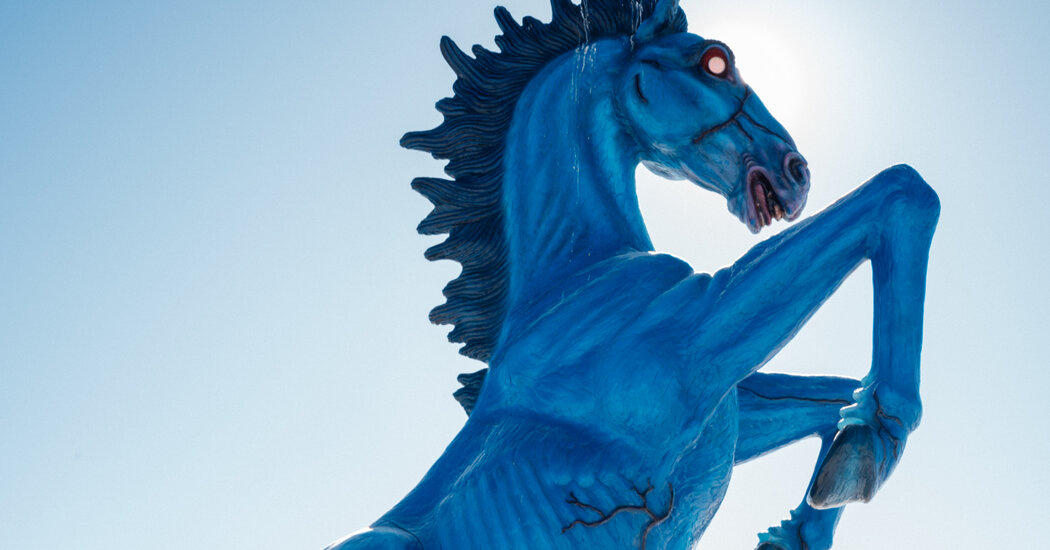Chasing Conspiracy Theories at the Denver Airport

Tiffany Hsu had planned to fly to Denver for a wedding. She got much more than she bargained for.
Times Insider explains who we are and what we do and delivers behind-the-scenes insights into how our journalism comes together.
Tiffany Hsu, who reports on misinformation for The New York Times, was researching flights to Denver for a wedding late last year when she Googled “Denver airport” — and an article about “lizard people” popped up.
“I was like, ‘What?’” she said in a recent interview.
She did some digging and came across conspiracy theories about the airport that involved secret world governments, reptilian humanoids, ghosts and aliens. One theory contended that the travel hub was the headquarters for the Illuminati. And “Mustang,” a cobalt-colored equine statue also known as Blucifer that stands on hind legs outside the airport, has captivated conspiracy theorists for 15 years. (Blucifer’s creator died finishing the statue in 2006 after a piece came lose and struck him.)
She pitched an article idea to The Times’s media editor, Joe Plambeck, who was immediately on board — and suddenly her trip to a wedding also became a reporting trip. The resulting article was a hit with readers online.
Ms. Hsu shared the craziest tales she came across, how she obtained access to the airport’s underground tunnels and how she balanced the desire to share interesting stories with the responsibility to debunk them. Read the edited interview below.
Where did you even start?
I flew in to Denver early on a Thursday, and I spent most of the day walking around and talking to people in the airport.
Did you find that the conspiracy theories were common knowledge?
I met a woman who used to work in Denver who was sitting right underneath an animatronic talking gargoyle. I asked her, “Are you aware of the conspiracy theories, including the ones that the gargoyles are satanic?” She’s sitting there under the gargoyle and saying: “No, I’ve never heard this. What is it?” And then the gargoyle piped up and said something ridiculous.
How long has the Denver International Airport had such an interesting reputation?
People were suspicious from the time that site was proposed in the late 1980s — it’s not a short drive from the airport to downtown Denver. You drive through a substantial stretch of plains. It’s very picturesque, you can see the mountains in the background, and it is actually quite lovely — but it is remote. So when administrators proposed building this airport in what felt like the middle of nowhere, people asked: “What’s going on? What are they trying to hide?”
How many people did you speak with?
Around two dozen. I talked to restaurant servers later on when I was in the city. I had an Uber driver who was going off on Blucifer and food storage mounds on the property to prepare for the apocalypse. It was pretty funny, because almost everyone had some sort of opinion on what was going on at the airport.
What about the airport staff?
I met an airport employee outside of baggage claim who was surprisingly chatty. He talked about some of the rumors about there being graves on the property, and about the Native American music that would play at night. The airport administrators have leaned into the theories to different degrees over the years. I think they recognize that helping with the story serves a dual purpose: It gives them a little boost of publicity, but it also serves as a debunking venue. It helps them, in some small way, reach people who might think that the stuff is true and offer evidence that it isn’t.
You took some creepy videos in tunnels underneath the airport. What was that like?
Stephanie Figueroa, who’s on the Denver airport communications staff, took me on a tour of the tunnels, which are a big part of the airport’s mythology. People think that they run for hundreds of miles, that they connect to NORAD [North American Aerospace Defense Command], or that they connect to these underground bunkers. But she took me down there and explained that these tunnels are mostly used to move luggage.
What was the most out-there story you heard?
The top of the Denver airport has what looks like white tents on the roof, and one of my friends said some people claim that those represent K.K.K. hoods, which isn’t true. One person told me that Blucifer’s eyes weren’t red and glowing until after the creator died, which also isn’t true. After my article was published, readers messaged me with stories of their own. One man told me he used to tell his kids that Blucifer would blast lasers out of his eyes and vaporize a passing car once a day.
How did you balance the desire to share these tall tales and lore with your journalistic responsibility to debunk them?
What I always hear from sources and researchers on this beat is that it’s important to understand where conspiracy theories come from. For a lot of people, they stem from deep belief systems that are developed over a long period of time. Even if certain stories can be proved untrue, it’s important and interesting for me as a reporter to excavate where that belief comes from, because it says a lot about how we defend against more dangerous conspiracy theories down the line.

